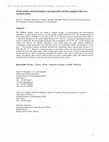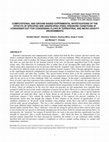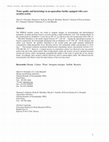Papers by Shantanu Kulkarni
A Practical Approach to Anesthesia for Emergency Surgery, 2011
A Practical Approach to Anesthesia for Emergency Surgery, 2011
ASME 2009 Second International Conference on Micro/Nanoscale Heat and Mass Transfer, Volume 2, 2009
This paper presents computational simulations for internal condensing flows over a range of tube/... more This paper presents computational simulations for internal condensing flows over a range of tube/channel geometries ranging from one micro-meter to several millimeters in hydraulic diameters. Over the mm-scale, three sets of condensing flow results are presented that ...

Environmental Monitoring and Assessment, 2010
The HOBAS aeration system was tested to compare changes in environmental and bacteriological para... more The HOBAS aeration system was tested to compare changes in environmental and bacteriological parameters in ponds growing Penaeus monodon during a single production cycle. The stocking density in the aerated pond was doubled to 12 post-larvae (PL) m − 2 in contrast to the non-aerated pond with 6 (PL) m − 2. Microbial abundance in the ponds ranged between 105 − 6 cells ml − 1. Among the physiological groups of bacteria enumerated, the heterotrophs dominated with an abundance of 104 CFU ml − 1. Of the nitrogen and sulfur cycle bacteria, the nitrifiers flourished in the aerated pond and could maintain ammonia-N concentration within permissible levels. Bacterial activity also maintained sulfide concentrations at − 1. Non-aerated conditions promoted denitrification maintaining nitrate concentration between 0.32 and 0.98 μM NO3 − -N l − 1. However, a marked increase in ammonium content was observed in the non-aerated pond at the end of the culture period. Thus in high-density ponds, the aerators served to stimulate bacterial growth and activity which consequently maintained the quality of the water to match that of low-density ponds. Accordingly, these aerators could be effectively used to sustain higher yields. The effluent from the aerated pond is less likely to alter the redox balance of the receiving waters.

This paper presents novel computational results obtained for the full 2-D governing equations of ... more This paper presents novel computational results obtained for the full 2-D governing equations of condensing flows in a channel (shear driven or gravity driven). It is shown that the internal condensing flows can be operated under two different boundary conditions at the exit, viz. unspecified exit condition and specified exit condition. These computational results state that for unspecified exit conditions, there exists a unique steady solution for the condensing flows, termed as ``natural'' solution. This ``natural'' solution is obtained by solving ``strictly'' steady governing equations. This paper demonstrates that the unsteady equations of condensing flows are elliptic and for the specified exit conditions different than the ``natural'' exit condition, one obtains an unsteady or quasi-steady solution based on the type of exit condition control. This paper demonstrates different ways to control the exit condition as well as solution attainability limits for gravity and shear driven flows.

Annals of the New York Academy of Sciences, 2009
Reported experimental and computational results confirm that both the flow features and heat tran... more Reported experimental and computational results confirm that both the flow features and heat transfer rates inside a condenser depend on the specification of inlet, wall, and exit conditions. When exit pressure is changed from one steady value to another, the changes required of the interior vapor flow towards achieving a new steady duct flow are such that they do not demand removal of the new exit pressure imposition back to the original steady value. This behaviour of condensing flow is unlike that of any incompressible single phase duct flow which cannot allow imposition of an exit pressure other than the "required" value. Instead, new steady flows may be achieved for different steady exit pressure prescriptions (termed category I flows) through appropriate changes in the vapor/liquid interfacial configurations and associated changes in interfacial mass, heat transfer rates (both local and overall), and other flow variables. This special feature of these flows is for the commonly occurring large heat sink situations for which the condensing surface temperature (not heat flux) remains approximately the same for any given set of inlet conditions while exit condition changes. In this paper's experimental context of flows of a pure vapor that experiences film condensation on the inside walls of a vertical tube, the reported results provide important quantitative and qualitative understanding. The theorotical and experimental results presented in this paper allow us to propose important exit-condition based categorization of these flows. Of these, category II flows, which are defined to be the cases for which exit pressures are left unspecified, have typically been assumed to hold for most actual steady realizations of gravity driven flows. However it is shown here that steady flows under self selected exit pressure conditions are achieved under these conditions only if special hardware arrangements are made that allow vapor to freely choose an exit pressure. If this is not so, one often has an inadvertent category I flow without the explicit knowledge of the imposed exit pressure condition. It is theoretically shown here that though this category II flow situation in the absence of specification of exit condition constitutes an "ill posed" steady boundary value problem, steady flows may still be experimentally realized under special arrangements. This fact is also validated by unsteady theory which shows that solutions from many different initial conditions may tend to a unique steady attracting solution (as t → ∞) for some of the internal and/or external flows. These "attractors" exist and are strong for gravity driven flows and are often weak to non-existent for zero gravity or horizontal shear/pressure driven flows (both for internal and external flows). In microgravity, the "attractors" for category II internal flows are weak in the sense that they significantly lose their strength of "attraction" after a certain downstream distance -after which the flows are indeterminate if exit pressure remains unspecified. For these microgravity situations, the remedy is to run condensers under suitably specified inlet and exit pressures (category I conditions) as well as a proper cooling strategy (i.e. proper wall temperature variations).

Environmental Monitoring and Assessment, 2010
The HOBAS aeration system was tested to compare changes in environmental and bacteriological para... more The HOBAS aeration system was tested to compare changes in environmental and bacteriological parameters in ponds growing Penaeus monodon during a single production cycle. The stocking density in the aerated pond was doubled to 12 post-larvae (PL) m − 2 in contrast to the non-aerated pond with 6 (PL) m − 2. Microbial abundance in the ponds ranged between 105 − 6 cells ml − 1. Among the physiological groups of bacteria enumerated, the heterotrophs dominated with an abundance of 104 CFU ml − 1. Of the nitrogen and sulfur cycle bacteria, the nitrifiers flourished in the aerated pond and could maintain ammonia-N concentration within permissible levels. Bacterial activity also maintained sulfide concentrations at − 1. Non-aerated conditions promoted denitrification maintaining nitrate concentration between 0.32 and 0.98 μM NO3 − -N l − 1. However, a marked increase in ammonium content was observed in the non-aerated pond at the end of the culture period. Thus in high-density ponds, the aerators served to stimulate bacterial growth and activity which consequently maintained the quality of the water to match that of low-density ponds. Accordingly, these aerators could be effectively used to sustain higher yields. The effluent from the aerated pond is less likely to alter the redox balance of the receiving waters.










Uploads
Papers by Shantanu Kulkarni